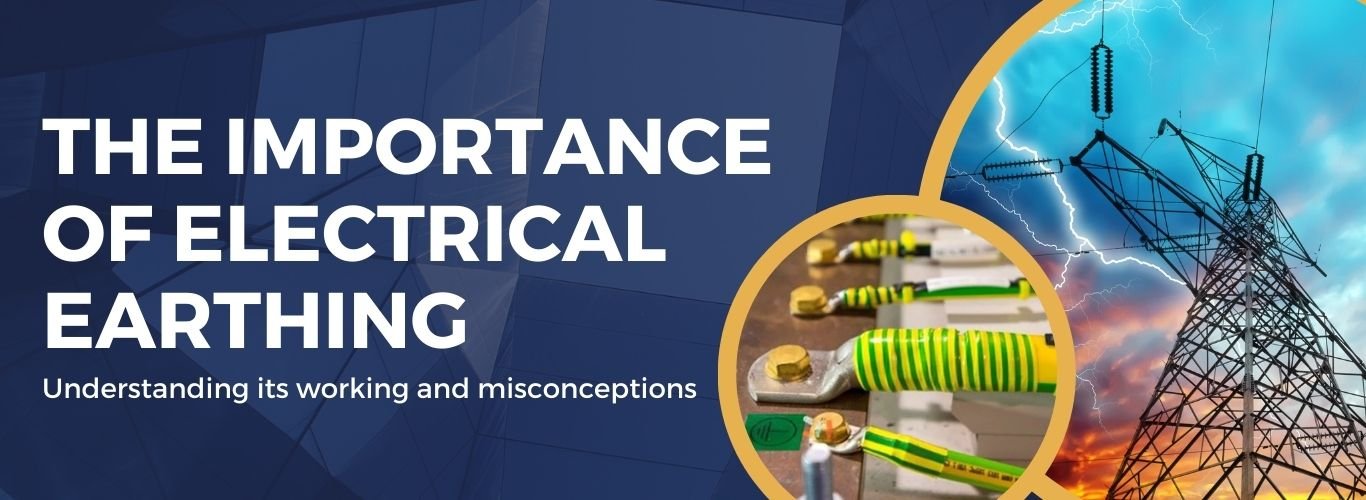Electrical earthing plays a vital role in preventing electrical mishaps and ensures the smooth functioning of various electrical systems. Electrical earthing refers to the practice of linking electrical devices and systems to the ground to safely channel and dissipate surplus electrical charges. It safeguards both people and equipment, preventing potential damage or injury.
Electrical earthing ensures smooth electricity flow, maintains proper voltage levels, and enhances overall system performance and longevity.
What is Electrical Earthing?
Electrical earthing, also known as grounding, is a fundamental concept in electrical safety that involves connecting electrical devices, systems, and structures to the Earth’s conductive surface. This connection provides a low-resistance pathway for any excess or stray electrical current to flow directly into the ground, ensuring the safe dissipation of electrical charges.
The main function of electrical earthing is to keep an electrical system’s voltage safe relative to the Earth’s surface by connecting it to the ground, preventing dangerous voltage build-up that could cause shocks, fires, or other electrical hazards. This is achieved by establishing a direct connection between the electrical system and the Earth, which acts as a vast, low-resistance reservoir for electrical charges.
Understanding the importance of earthing in electrical safety
Electrical safety is a paramount concern in today’s world, where the reliance on electricity has become pre-dominant. Electrical earthing plays a pivotal role in ensuring the safety of electrical systems, safeguarding both people and property from electrical hazards.
-
Safeguarding Electrical Systems:
In the event of an electrical fault, such as a short circuit or a ground fault, the earthing system diverts excess electric current away into the ground, preventing catastrophic events.
It protects electrical equipment from damage of power surges and lightning strikes. When a lightning bolt strikes, the earthing system provides a low-resistance path for the electrical discharge to flow safely into the ground, preventing damage to electronic components and electrical installations.
-
Stabilizing Voltage Levels
Electrical earthing helps to stabilize the voltage levels within an electrical system, ensuring that they remain within safe and optimal ranges. Fluctuations in voltage, such as those caused by power surges or lightning strikes, can severely damage electrical equipment and pose a significant risk to anyone in proximity. By providing a reliable path for these electrical disturbances to dissipate, earthing helps to protect both people and equipment from the harmful effects of voltage variations.
-
Ensuring System Reliability and Performance
Electrical earthing not only mitigates electrical hazards but also ensures the reliability and performance of electrical systems. By maintaining a stable and consistent electrical environment, earthing helps to prevent premature failures, extend the lifespan of electrical components, and ensure the smooth and efficient operation of electrical installations.
How does earthing work to prevent electrical accidents?
Earthing is a fundamental mechanism that plays a crucial role in preventing electrical accidents and safeguarding both people and equipment. The way earthing works to achieve this is through the establishment of a low-resistance path for electrical current to flow, which is essential in maintaining the safety and stability of electrical systems.
Fault Occurrence:
When an electrical fault or a short circuit occurs, the excess current generated needs a path to dissipate safely. Without a proper earthing system, this current would seek alternative routes, potentially flowing through the human body or other conductive materials, leading to electric shocks, fires, or other hazardous situations.
Need for Safe Dissipation:
Without a proper earthing system, the excess current would seek alternative paths, which could include flowing through the human body or other conductive materials. This unintended current flow can result in electric shocks, fires, or other dangerous situations.
Earthing System Activation:
The earthing system provides a dedicated low-resistance path for the electrical current to flow directly into the ground. This system ensures that the current is safely directed away from people and equipment.
Earth Electrode:
The pathway for the current, known as the earth electrode, is usually a metal rod or a network of interconnected conductive materials buried in the soil. The low resistance of this electrode facilitates smooth and efficient current flow, thereby preventing the buildup of dangerous voltages that could cause harm.
Current Flow:
By providing a safe pathway, the earthing system ensures that the electrical current flows efficiently into the ground. This prevents the accumulation of hazardous voltages and maintains the stability of the electrical system.
Voltage Stabilization:
Earthing helps maintain the voltage levels within the electrical system at a safe level relative to the Earth’s surface. This stabilization is critical in preventing electric shocks, as it minimizes the potential difference between the electrical system and the Earth.
Protection from Surges:
Earthing is crucial for protecting electrical equipment from damage caused by power surges and lightning strikes. When lightning strikes a building or electrical system, the earthing system provides a conduit for the electrical discharge to safely flow into the ground, safeguarding sensitive electronic components and ensuring the electrical installation remains operational.
4 Common Misconceptions about Electrical Earthing
Despite the crucial importance of earthing in electrical safety, there are several common misconceptions that can lead to misunderstandings and potentially dangerous situations. It is essential to address these misconceptions to ensure a proper understanding of the role and function of earthing systems.
Misconception 1:
Many believe that earthing is only necessary for high-voltage or industrial electrical systems. In reality, electrical earthing is equally important for low-voltage and residential electrical installations. Even in household electrical circuits, earthing provides a vital safety mechanism to protect against electrical faults and prevent the risk of electric shocks.
Misconception 2:
Another misconception is that earthing is only required to protect electrical equipment. While this is indeed one of the key benefits of earthing, the primary purpose is to safeguard human life. By providing a safe path for electrical current to flow, earthing helps to minimize the risk of electric shocks, which can be potentially fatal.
Misconception 3:
Some people also believe that earthing is only necessary in areas with a high risk of lightning strikes. However, the importance of earthing extends far beyond just lightning protection. Electrical faults, power surges, and other electrical disturbances can occur in any electrical system, regardless of location, and earthing is essential for mitigating these risks.
Misconception 4:
Lastly, most believe that earthing is a simple and straightforward process that can be easily implemented without professional expertise. In reality, designing and installing an effective earthing system requires a thorough understanding of electrical principles, local regulations, and best practices. Attempting to implement an earthing system without the guidance of qualified professionals can lead to unsafe and potentially dangerous outcomes.
Steps ensuring proper earthing in your electrical system
Ensuring proper earthing in your electrical system is a crucial step in maintaining safety and protecting both people and equipment. To achieve this, there are steps that should be followed:
- Understand the local regulations and standards: Begin by familiarizing yourself with the relevant electrical codes, regulations, and standards that apply to your specific location and the type of electrical installation you have. These guidelines will provide the necessary information on the requirements for earthing systems, including the minimum resistance values, grounding electrode materials, and installation methods.
- Assess the existing earthing system: Carefully inspect the existing earthing system to evaluate its condition and effectiveness. Look for signs of corrosion, damage, or improper installation, and measure the resistance of the earthing system to ensure it meets the required standards.
- Consult with qualified professionals: Engage the services of licensed electricians, electrical engineers, or earthing specialists to assess your electrical system and design an appropriate earthing solution. These professionals have the expertise to evaluate the specific requirements of your installation and recommend the most effective earthing system.
- Ensure proper installation: When installing or upgrading the earthing system, it is crucial to follow the recommended installation practices and use the appropriate materials. This may involve the installation of grounding electrodes, such as copper rods or plates, and the proper connection of the earthing system to the electrical equipment and the building’s structure.
- Regular Inspection: Earthing systems require periodic inspection and maintenance to ensure their continued effectiveness. Schedule regular checks to identify any issues, such as corrosion or loose connections, and perform necessary repairs or replacements to keep the system in optimal condition.
- Documentation: Maintain detailed records of the earthing system, including the design, installation, and test results. This documentation can be invaluable in the event of future modifications, inspections, or troubleshooting.
By following these steps, you can ensure that your electrical system is equipped with a robust and reliable earthing system, providing the necessary protection against electrical hazards and safeguarding both people and equipment.
Conclusion
Electrical earthing is a fundamental aspect of electrical safety and plays a crucial role in protecting people, property, and electrical equipment from electrical hazards.
Despite its importance, common misconceptions about earthing can lead to dangerous oversights. It is essential to educate ourselves and others about the true purpose and function of earthing systems, dispelling these myths and promoting a better understanding of this critical safety measure.
As our reliance on electricity grows, the role of earthing becomes increasingly essential, making it a cornerstone of modern electrical infrastructure and a vital safeguard for both people and property.






